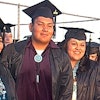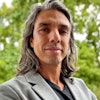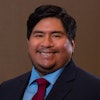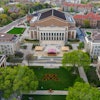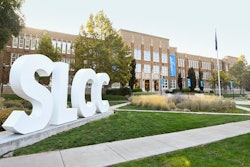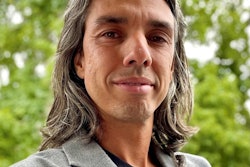 Preserving Native Traditions
Preserving Native Traditions
The National Museum of the American Indian gives Native peoples, scholars permission to claim their voices, share their storiesBy Kendra Hamilton
There’s a monumental new presence rising above the elm trees on the National Mall in Washington, D.C., — and it’s not like anything else you’ll see there. It’s as if a vision from an ancient cliff city of the desert Southwest — five stories worth of honey-colored limestone, rough hewn as if by the wind yet flowing like a river of curving cantilevered walls — had been plopped down at the back door of the U.S. Capitol.
The note the building strikes amid the sea of square-cut white marble that surrounds it could be discordant. Could be, but somehow it’s not. Somehow, the National Museum of the American Indian (NMAI) sings its own song — about man and the natural world and cultures yanked back from the edge of extinction — and manages to harmonize with the rest of the Smithsonian complex.
Clearly, this is a moment to savor. The $219 million museum is “last”— it’s the 16th museum in the Smithsonian family, occupying the last open museum space on the Mall. And it’s also a “first,” representing the first time national resources and a national museum have been devoted to a non-White culture.  “We’re profoundly aware of the honor,” museum Director W. Richard West, a member of the Cheyenne and Arapaho tribes and a Stanford-educated corporate lawyer, said at the opening.
“We’re profoundly aware of the honor,” museum Director W. Richard West, a member of the Cheyenne and Arapaho tribes and a Stanford-educated corporate lawyer, said at the opening.
And Native peoples everywhere are celebrating.
“This is an exciting time for Indian people,” says Dr. Joseph McDonald, founder and president of Salish Kootenai College in Pablo, Mont., and president of the American Indian Higher Education Association. “For three decades, tribal colleges and universities have been working to preserve and vitalize our cultures and traditions. Now we have an important collaborative resource.”
And it’s not just a collaborative resource, but also a valuable public relations and  educational tool. Not quite two months after the ballyhooed opening in late September, the official tally of visitors stands at 444,700, says NMAI spokeswoman Amy Drapeau, adding that the annual estimate of 4 million visitors a year seems well within reach.
educational tool. Not quite two months after the ballyhooed opening in late September, the official tally of visitors stands at 444,700, says NMAI spokeswoman Amy Drapeau, adding that the annual estimate of 4 million visitors a year seems well within reach.
That’s enormously important, notes Dr. Jason Baird Jackson, a professor of ethnomusicology and folklore at Indiana University, former curator of the Sam Noble Oklahoma Museum of Natural History and author of Yuchi Ceremonial Life: Performance, Meaning and Tradition in a Contemporary American Indian Community.
“No one can deny it’s a fantastically positive moment and achievement for Native American peoples in the United States — just in terms of what it means to be on the Mall, the political power of that, the capacity to educate vast numbers of people. There’s a huge potential for positive impact both on people and policy-makers,” he says.
But it’s also an ambivalent moment. “What is the meaning of the museum for  scholars and for the larger Native community? I think that remains to be seen,” says Anjana Mebane Cruz, who’s wrapping up a dissertation in the emerging field of Black-Indian convergences in the University of Virginia’s department of anthropology.
scholars and for the larger Native community? I think that remains to be seen,” says Anjana Mebane Cruz, who’s wrapping up a dissertation in the emerging field of Black-Indian convergences in the University of Virginia’s department of anthropology.
Ambivalence might seem an odd response, especially when one considers that, for the first-time visitor to the exhibit, the keynote of the initial encounter is harmony. The in-your-face nature of the architecture is just one radical departure from the other museums on the Mall. Then there are the subtle dimensions of the experience. For example, there is no north — or Mall-side — entrance to the building. The main entrance faces east to greet the morning sun (and the U.S. Capitol).
The in-your-face nature of the architecture is just one radical departure from the other museums on the Mall. Then there are the subtle dimensions of the experience. For example, there is no north — or Mall-side — entrance to the building. The main entrance faces east to greet the morning sun (and the U.S. Capitol).
Much is made of the symbolism of the cardinal directions. Each face of the building has a directional marker taken from the far corners of Native culture: from Great Falls, Md., for the eastern face; from Puntos Arenas, Chile, for the southern; from Hawaii for the western; and from the Northwest Territories, Canada, for the northern.
Similarly, each direction has its own habitat. On the north side there is an upland hardwood forest complete with a waterfall; to the east side, there’s a lowland freshwater wetland, which for a time this fall was a magnet for migrating geese; to the south, there’s a meadowland; and to the west, a cropland area where the sacred herb tobacco and the “three sisters” of corn, beans and squash were planted until the frost came to kill them.
The same attention to native forms and orientations is lavished within, and the combined effect carries a powerful emotional charge.
“It’s amazingly affirming,” says Cruz, who has Cherokee and African American ancestry, of her encounters with the soaring heights of the “Potomac” atrium space and the circular or flowing and riverine forms of the exhibit spaces.
“I was really worried about what I would see, whether they would ‘get it right,'” Cruz adds. “And I have to say it was an overwhelmingly positive experience. It changed my ideas about sections of my dissertation. There were experiences, encounters, I’d had that I had decided to leave out. Now I’m thinking, when I do the book revisions, I’m going to go back and put those sections back in.”
Museum staffers explain that this is precisely the intention of their concern with “Native authority.” They want to give Native people and Native scholars permission to claim their voice and share their story.
“It all comes from the museum’s mission of collaborating and consulting with Native communities,” says Thomas Sweeney, director of public affairs for the museum, noting that the NMAI was, in fact, authorized 15 years ago and had collections and a staff long before the first shovel of earth was turned for the Washington site. “We undertook four years of consultation sessions around ‘Indian country’ in order to make all these decisions. There were a lot of opinions and a lot of differences, but we discovered a lot of commonalities, too.”
Working with Indian communities, Indian curators and Indian designers allowed all parts of the project, from the design of the building to the smallest details of the exhibits, to be infused with meaning and symbolism, Sweeney adds.
It’s an approach that stands as an almost implicit rebuke to the Smithsonian’s other Indian-focused institution, the Museum of Natural History, which for years was home to old-fashioned dioramas containing dusty mannequins wearing moldering loincloths. 
One could say that Natural History was famous as a scientific repository of American Indian artifacts — or that it was infamous among Indians as a storehouse of artifacts looted by scientists from sacred sites. There are elements of truth in both views. But whatever view one takes, there’s no disputing that one of its most loathsome possessions — the one most emblematic of the approach the National Museum of the American Indian is attempting to critique — was the brain of Ishi, a man exhibited for many years in a San Francisco museum as the last living member of California’s Yahi tribe. Ishi’s brain was given to the Smithsonian as a gift, and Natural History held it in storage for 83 years, only returning it to his kin in 2000.
Interestingly, there is only one reference to Ishi’s heartbreaking tale in the new museum — a photograph of a loincloth-clad performance artist re-enacting Ishi’s plight by posing in a glass case. And this itself accounts for the ambivalence among some in the Indian community about the new museum. That is to say, the museum is being criticized for containing too much celebration with too little context.
Indeed, the Grand Governing Council of the American Indian Movement spilled cold water on the warmth of the opening. Noting that the Smithsonian “still holds in its vaults thousands of skulls and skeletal remains and funerary objects of our ancestors,” its press release said, “the museum falls short in that it does not characterize nor does it display the sordid and tragic history of America’s holocaust against the Native Nations and peoples of the Americas.”
This is the crux of the difficulty faced by the museum. When one has a collection of 800,000 items that must be narrowed to 8,000 items for exhibition, and when one is charged with telling a story with a 10,000-year sweep, decisions have to be made that some will interpret as compromises. Indeed, one can well imagine that titanic battles had to be waged behind the scenes to create the harmony that appears on the museum’s gorgeous surfaces.
“This is the dilemma that the museum has to confront,” says Jackson. “They’re challenging anthropology but they are, in fact, anthropologists. They’re throwing out colonial legacy, the scientific directive for separating and classifying and putting everything into boxes. But in so doing, one has to ask, are they also throwing out the only good available scholarly scheme whereby differences can be articulated?”
The opening is certainly a big event and a positive thing, Jackson continues, “but the interesting questions for scholars are going to have to do with the place of this museum in a larger museum world as well as in the world of smaller, local and regional Native museums where really exciting things are starting to happen.
“It’ll be fascinating to see how it all plays out.”
© Copyright 2005 by DiverseEducation.com

